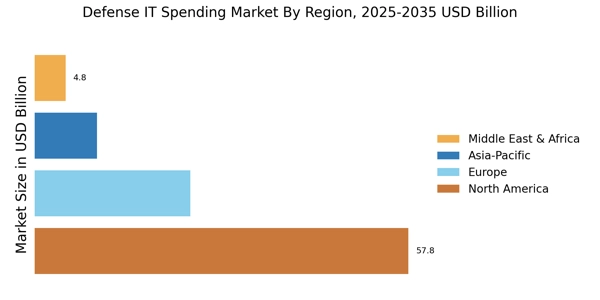Technological Advancements
Technological advancements are a pivotal driver in the Defense IT Spending Market. The rapid evolution of technologies such as artificial intelligence, machine learning, and cloud computing is reshaping defense strategies and operational frameworks. As military organizations seek to integrate these technologies, spending on IT infrastructure is expected to rise. Reports indicate that defense IT budgets are projected to grow by approximately 8% annually, reflecting the urgency to adopt cutting-edge solutions. This trend not only enhances operational capabilities but also improves data analytics and decision-making processes. Consequently, the Defense IT Spending Market is poised for expansion as defense entities invest in innovative technologies to address emerging threats and improve overall mission effectiveness.
Rising Geopolitical Tensions
The Defense IT Spending Market appears to be significantly influenced by rising geopolitical tensions across various regions. Nations are increasingly allocating resources to enhance their defense capabilities, which includes substantial investments in information technology. For instance, defense budgets have seen a marked increase, with many countries reporting growth rates of 5-10% annually in their IT spending. This trend suggests that governments are prioritizing advanced technologies to bolster national security and maintain strategic advantages. As a result, the Defense IT Spending Market is likely to experience robust growth, driven by the need for enhanced cybersecurity measures, intelligence gathering, and operational efficiency. The emphasis on modernization and technological superiority indicates a long-term commitment to investing in defense IT solutions.
Increased Cybersecurity Threats
The Defense IT Spending Market is increasingly driven by the rise in cybersecurity threats that pose significant risks to national security. With the proliferation of cyberattacks targeting military and defense systems, governments are compelled to invest heavily in cybersecurity measures. Recent data indicates that defense organizations are allocating upwards of 20% of their IT budgets to cybersecurity initiatives. This focus on protecting sensitive information and critical infrastructure is likely to propel the growth of the Defense IT Spending Market. As threats evolve, the demand for advanced cybersecurity solutions, including threat detection and response systems, is expected to surge, further driving IT expenditures in the defense sector.
Regulatory Compliance and Standards
Regulatory compliance and standards are becoming increasingly critical in the Defense IT Spending Market. Governments are implementing stringent regulations to ensure that defense organizations adhere to security protocols and data protection measures. This regulatory landscape necessitates significant investments in IT systems that can meet compliance requirements. As a result, defense entities are likely to increase their IT spending to upgrade existing systems and implement new technologies that align with regulatory standards. The emphasis on compliance not only enhances security but also fosters trust among stakeholders. Consequently, the Defense IT Spending Market is expected to witness growth as organizations prioritize investments in compliant IT solutions to mitigate risks and enhance operational integrity.
Collaboration with Technology Providers
Collaboration with technology providers is emerging as a key driver in the Defense IT Spending Market. Defense organizations are increasingly partnering with private sector technology firms to leverage their expertise and innovative solutions. This trend is indicative of a shift towards more agile and responsive defense strategies, where external collaboration enhances capabilities. Reports suggest that partnerships can lead to a 15-25% increase in efficiency and effectiveness in defense operations. As defense entities seek to modernize their IT infrastructure, these collaborations are likely to result in increased spending on advanced technologies and services. The Defense IT Spending Market is thus expected to benefit from this trend, as organizations invest in partnerships that drive innovation and operational excellence.


















Leave a Comment